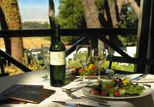Wine Grape Varieties in South Africa
Wine Grape Varieties in South Africa
Wynboer published the following interesting information about grape varieties in South Africa:
MOST IMPORTANT WINE GRAPE VARIETIES ACCORDING TO NUMBERS (TOTAL VINES)
Chenin Blanc, with 18,5 per cent (19,4% in 2002) of total vines planted, is still the most important variety in the South African wine industry based on total number of vines. Table 2 shows the ten most important wine grape varieties according to numbers (total number of vines). The shift in positions since 2000 is also indicated.
All six so-called "noble" varieties ("Big six"), namely Cabernet Sauvignon (second with 12,2%), Shiraz (fourth with 7,6%), Chardonnay (fifth with 6,8%), Merlot (sixth with 6,5%), Sauvignon Blanc (seventh with 6,4%), and Pinotage (eighth with 6,3%) count among the top ten varieties.
2. MOST IMPORTANT WINE GRAPE VARIETIES ACCORDING TO NUMBER OF VINES PLANTED - 1 DECEMBER 2002 TO 30 NOVEMBER 2003
Cabernet Sauvignon is the variety of which the most and Chardonnay the variety of which the second most vines were planted in 2003. The position of Chenin Blanc improved from fifth position in 2002 to third position in 2003. The position of Colombar did not change from 2002 to 2003, it remains in the sixth position. Table 3 shows the ten most important wine grape varieties planted in 2003 based on the number of vines.
All the "noble" varieties namely Chardonnay, Cabernet Sauvignon, Merlot, Shiraz and Sauvignon Blanc, except Pinotage, counted among the ten most planted varieties in 2003.
Figure 1 shows the total number of wine grape vines per area in hectares for each of the eight wine regions from 2001 to 2003, expressed as a percentage of the total number of wine grape vines in South Africa.
Figure 2 shows the total plantings of white and red varieties in hectares, expressed as a percentage of the total plantings for the period 1996 to 2003. It is clearly noticeable how the percentage plantings of red varieties increased annually from 34% in 1996 to 82% in 2001. In 2002, however, there is a decrease to 65% and a further decrease to 51% in 2003, in the plantings of red varieties as a percentage of total plantings. On the other hand, there was an annual decrease in the percentage plantings of white varieties from 66% in 1996 to 35% in 2002. In 2003, however, we see an increase to 49% in the plantings of white varieties as a percentage of total plantings.
In 2003 white varieties represented three of the five varieties that were most uprooted, Chenin Blanc being the most uprooted with a percentage of 30,45% (2001 - 28,3%) of all vines that were uprooted.
Wynboer published the following interesting information about grape varieties in South Africa:
MOST IMPORTANT WINE GRAPE VARIETIES ACCORDING TO NUMBERS (TOTAL VINES)
Chenin Blanc, with 18,5 per cent (19,4% in 2002) of total vines planted, is still the most important variety in the South African wine industry based on total number of vines. Table 2 shows the ten most important wine grape varieties according to numbers (total number of vines). The shift in positions since 2000 is also indicated.
All six so-called "noble" varieties ("Big six"), namely Cabernet Sauvignon (second with 12,2%), Shiraz (fourth with 7,6%), Chardonnay (fifth with 6,8%), Merlot (sixth with 6,5%), Sauvignon Blanc (seventh with 6,4%), and Pinotage (eighth with 6,3%) count among the top ten varieties.
2. MOST IMPORTANT WINE GRAPE VARIETIES ACCORDING TO NUMBER OF VINES PLANTED - 1 DECEMBER 2002 TO 30 NOVEMBER 2003
Cabernet Sauvignon is the variety of which the most and Chardonnay the variety of which the second most vines were planted in 2003. The position of Chenin Blanc improved from fifth position in 2002 to third position in 2003. The position of Colombar did not change from 2002 to 2003, it remains in the sixth position. Table 3 shows the ten most important wine grape varieties planted in 2003 based on the number of vines.
All the "noble" varieties namely Chardonnay, Cabernet Sauvignon, Merlot, Shiraz and Sauvignon Blanc, except Pinotage, counted among the ten most planted varieties in 2003.
Figure 1 shows the total number of wine grape vines per area in hectares for each of the eight wine regions from 2001 to 2003, expressed as a percentage of the total number of wine grape vines in South Africa.
Figure 2 shows the total plantings of white and red varieties in hectares, expressed as a percentage of the total plantings for the period 1996 to 2003. It is clearly noticeable how the percentage plantings of red varieties increased annually from 34% in 1996 to 82% in 2001. In 2002, however, there is a decrease to 65% and a further decrease to 51% in 2003, in the plantings of red varieties as a percentage of total plantings. On the other hand, there was an annual decrease in the percentage plantings of white varieties from 66% in 1996 to 35% in 2002. In 2003, however, we see an increase to 49% in the plantings of white varieties as a percentage of total plantings.
In 2003 white varieties represented three of the five varieties that were most uprooted, Chenin Blanc being the most uprooted with a percentage of 30,45% (2001 - 28,3%) of all vines that were uprooted.
